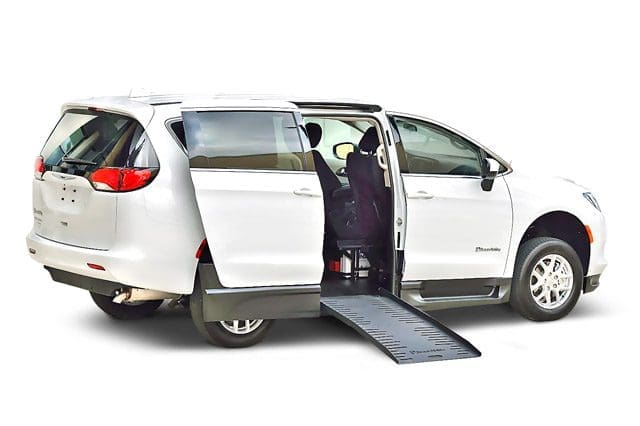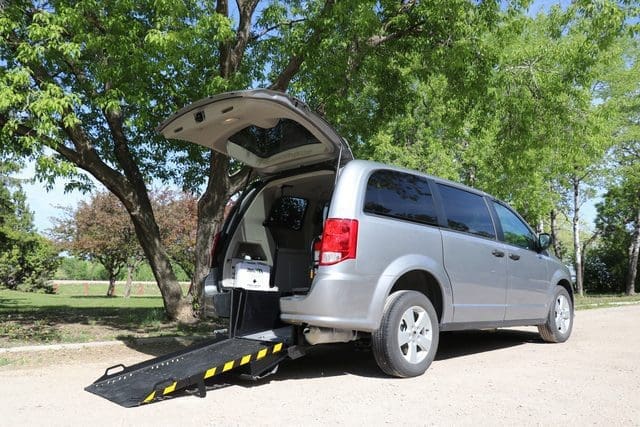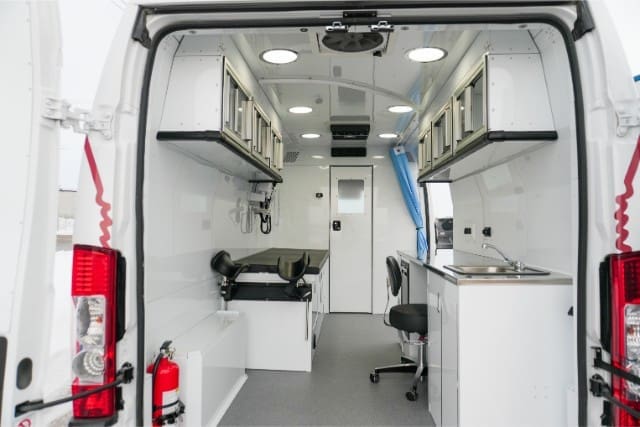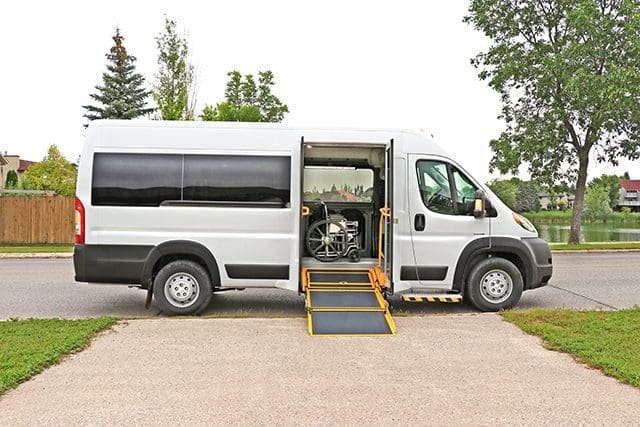Electric wheelchair vans and hybrid wheelchair vans are two options your organization might be considering to lower your carbon footprint on the environment. While both of these options have their pros, you should also be aware of their cons. They’re more expensive, have a limited range, and the plug-in ones require charging infrastructure to keep them going.
At MoveMobility, we’re all about designing vehicles that get rid of barriers to healthcare and transportation. We’ve manufactured hundreds of wheelchair accessible and mobile medical vehicles that improve rider dignity, easy access to medical care, and reliable transportation.
In this article, you’ll learn the pros and cons of electric wheelchair vans and hybrid wheelchair vans. After reading it, you’ll leave with a better idea of how these options will work for your organization.
What is an electric wheelchair van?
An electric wheelchair van is a specially designed vehicle that helps people with mobility challenges get around more easily. These vans are a practical solution for individuals who use wheelchairs, as they provide a convenient and accessible mode of transportation. Let’s break down the basics:
Electric power: Electric wheelchair vans run on electricity, which means they’re powered by batteries. These batteries are rechargeable and offer a clean and eco-friendly method of transportation. The electricity powers the van’s motor, allowing it to drive.
Accessibility: Aside from electric power, one of the key features of electric wheelchair vans is their accessibility. These vehicles are equipped with ramps or lifts that make it easy for wheelchair users to get in and out of the van. This eliminates the need for someone to physically lift the wheelchair and its occupant into the vehicle, ensuring greater independence.
Spacious interior: Inside the van, there’s plenty of room for both the wheelchair user and other passengers. The interior is designed to accommodate the wheelchair securely, and there are additional seats for family members or caregivers.
Controls: Driving an electric wheelchair van is designed to be straightforward. The driver operates the van using standard controls like a steering wheel, accelerator pedal, and brake pedal, just like any other vehicle. Some adaptations can be made for individuals with specific mobility needs.
Pros of electric wheelchair vans
Electric wheelchair vans offer several advantages:
Quiet Operation: Electric vans run quietly and offer a peaceful and comfortable ride for passengers. They also reduce noise pollution in urban areas.
Lower fuel costs: Electric vans have lower fuel costs compared to gasoline or diesel vans, leading to long-term savings.
Comfort: These vans provide a comfortable and spacious interior, ensuring a pleasant ride.
Environmentally friendly: Electric power means they produce no harmful emissions, making them eco-friendly.
No gas: You don’t have to worry about filling your wheelchair van with gas every time it runs out.
Cons of electric wheelchair vans
It’s also important to consider the potential downsides of electric wheelchair vans:
Limited range: Electric vans have a limited driving range on a single charge, which may not be suitable for long trips. On average, they can only go between 100 – 125 km on a single charge.
Charging time: Recharging the batteries takes time, so planning trips and ensuring a fully charged battery is essential.
Initial cost: Electric wheelchair vans can be more expensive to purchase initially compared to traditional gasoline or hybrid models.
Electric wheelchair van example
Let’s look at an example of how the limited range of electric wheelchair vans can pose a challenge.
Meet Sarah, a teenager who uses a wheelchair for mobility. Her family owns an electric wheelchair van, which has made daily life easier. They decided to take a family road trip to the beach. However, their van’s limited range became a challenge.
As they set off, the van’s batteries were fully charged, and they planned stops at charging stations along the way. Unexpectedly, they encountered a road closure, forcing a detour and adding extra miles to the trip. After checking the van’s battery level, they realized it was lower than expected.
Anxiety set in as they searched for a nearby charging station, only to find it out of order. Desperate calls for alternatives proved mostly futile. With the van’s battery running low, they had to cut their trip short and head back home.
For Sarah, it meant missing out on the beach. This experience highlights the challenges of limited-range electric wheelchair vans. Although her family did their best to adapt, unexpected issues like this can be frustrating.
In Sarah’s story, we see how the limited range of electric wheelchair vans can affect not just the logistics but also the emotions and experiences of those who rely on them, emphasizing the need for other accessible travel solutions, such as gas-powered ones.
What is a hybrid wheelchair van?
A hybrid wheelchair van is another special kind of vehicle that helps people with mobility challenges. It’s different because it uses two types of power: electricity and gasoline. This makes it a smart and eco-friendly choice. Let’s explore what makes these vans unique:
Hybrid wheelchair vans have two power sources:
Electric power: When driving at slower speeds or for short trips, they use electricity. This is quiet and clean, making it good for the environment.
Gasoline power: For longer trips or when more power is needed, they switch to gasoline. This gives them a longer driving range.
Just like electric wheelchair vans, hybrids are designed with features to help wheelchair users with the following features:
Ramps or lifts: These vans have ramps or lifts to make it easy for people in wheelchairs to get in and out of the van independently.
Roomy interior: Inside, there’s plenty of space for the wheelchair and extra seats for passengers, ensuring everyone is comfortable.
Pros of hybrid wheelchair vans
There are some good things about hybrid vans:
Distance: They can travel longer distances, so they’re suitable for both short trips and longer journeys. Hybrid wheelchair vans get around 36 mpg of fuel efficiency.
Eco-friendly: Using electricity for short trips means fewer harmful emissions, which is better for the planet.
Flexible: Hybrids can adapt to different driving needs without sacrificing accessibility.
Less charging stress: Because they can use both gasoline and electricity, you don’t have to worry as much about finding charging stations.
Cons of hybrid wheelchair vans
There are a few things to consider with hybrid wheelchair vans:
Cost: These vans can be more expensive to buy than regular gasoline vans.
Maintenance: Because they have more complex systems due to the dual power process, they need more maintenance.
Charging infrastructure: Full hybrids use the gas engine to charge the batteries while it’s running. While charging infrastructure doesn’t apply to full hybrids or mild hybrids, it does apply to plug-in hybrids. Depending on your location and the type of hybrid vehicle you’re using, finding suitable charging stations for the plug-in ones can be challenging.
Hybrid wheelchair van example
Let’s consider an example where choosing a hybrid wheelchair van can backfire.
Alex runs an organization called AccessOn Wheels. They got a new hybrid van because it seemed like a great idea. It was roomy, eco-friendly, and could go a long way on a single tank of gas and electric power.
When the new hybrid van arrived, everyone at AccessOn Wheels was excited. It looked cool, and they thought it was a perfect fit for their job of helping people get around. But as time went on, they started having problems.
Fixing the hybrid wheelchair van when something went wrong turned out to be really expensive. It wasn’t like their old gasoline vans, which were simpler to repair. The high repair bills were taking a big bite out of their budget.
Alex and the team had a tough decision to make. They wanted to keep helping their clients, but the hybrid van was costing them a lot in repairs. They had to figure out how to make things work without breaking the bank.
The high maintenance costs meant they had to cut back on how many people they could help. They couldn’t take on as many new clients, and that was a big problem. Some people in the community couldn’t get the rides they needed, and that really bothered Alex and the team.
To fix the problem, Alex started looking for extra money or partners who could help pay for the maintenance. They even thought about going back to their gas-powered vans, which were easier and cheaper to take care of.
When is a gas-powered wheelchair van a better choice?

There are some scenarios where using a gas-powered wheelchair van would be a better choice.
In remote areas: Gas-powered wheelchair vans are ideal in areas that are far away from cities where you can’t easily find charging stations. Gas vans can travel longer without needing to recharge at all, so they’re more practical in such areas.
Quick response needs: Sometimes, there are jobs that require vans to arrive in an area quickly due to the nature of the medical needs in the community. Gas vans can be refueled more quickly than electric ones, and they’re always ready to go.
Extreme weather: If you live in a place with really hot or cold weather like Manitoba, electric vans won’t work as well. Gas vans are more reliable in these tough conditions. Very cold temperatures reduce the efficiency of electric vehicle batteries.
When money is tight: Gas vans are cheaper to buy than electric or hybrid ones. If your organization doesn’t have a lot of money to spend, getting a gas van is a smarter move.
Long trips: If your organization travels long distances to provide services, like going across the country, gas vans can cover more ground without needing to stop and charge up.
Familiarity with gas: If your team is already used to working with gas vehicles, switching to gas wheelchair vans might be easier. You won’t have to learn new things about technology or how to take care of them.
In these cases, regular gas wheelchair vans are a better fit because they offer reliability, distance, and convenience that are more suitable for specific needs. Always think about what works best for your situation before choosing a van.
Your next steps with MoveMobility

You made it to this article while researching electric wheelchair vans and hybrid options. You learned about the pros and cons of each, and we left you with some considerations and scenarios to think about where gas-powered wheelchair vans are the better option.
At MoveMobility, we’ve been manufacturing gas-powered wheelchair accessible vans and mobile medical vans for well over 10 years. We’ve helped hundreds of wheelchair van solutions for mobile medical vans for their organizations, and we’d be thrilled to help you find yours.
While you might still be thinking about the electric or hybrid options, we urge you to read through these two articles:
Alternatively, if you have any lingering questions you can’t seem to figure out, talk to an expert today.








